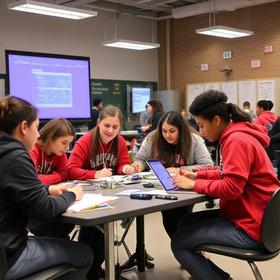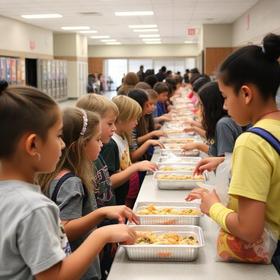Serving 37 students in grades 6-8, Desmet 6-8 ranks in the bottom 50% of all schools in Montana for overall test scores (math proficiency is top 50%, and reading proficiency is top 50%).
The percentage of students achieving proficiency in math is 40-49% (which is higher than the Montana state average of 37%). The percentage of students achieving proficiency in reading/language arts is 30-39% (which is lower than the Montana state average of 46%).
The student-teacher ratio of 7:1 is lower than the Montana state level of 12:1.
Minority enrollment is 30% of the student body (majority Hispanic), which is higher than the Montana state average of 23% (majority American Indian and Hispanic).
Quick Facts (2025-26)
- Grades: 6-8
- Enrollment: 37 students
- Student-Teacher Ratio: 7:1
- Minority Enrollment: 30%
- Overall Testing Rank: Bottom 50% in MT
- Math Proficiency: 40-49% (Top 50%)
- Reading Proficiency: 30-39% (Btm 50%)
- Science Proficiency: <50% (Top 30%)
- Source: National Center for Education Statistics (NCES), MT Dept. of Education
Top Rankings
Desmet 6-8 ranks among the top 20% of public schools in Montana for:
Category
Attribute
Diversity
School Overview
Desmet 6-8's student population of 37 students has grown by 54% over five school years.
The teacher population of 5 teachers has grown by 25% over five school years.
Grades Offered
Grades 6-8
(Supplemental Virtual)
(Supplemental Virtual)
Total Students
37 students
Gender %
Total Classroom Teachers
5 teachers
Year Founded
1905
Last Day of School
Mon. May 25, 2026
Campus Size
50 acres
School Motto
'Truth and Honor'
School Mascot
Wild Boars
School Rankings
Desmet 6-8 ranks within the bottom 50% of all 696 schools in Montana (based off of combined math and reading proficiency testing data).
The diversity score of Desmet 6-8 is 0.47, which is more than the diversity score at state average of 0.40. The school's diversity has stayed relatively flat over five school years.
Overall Testing Rank
#435 out of 696 schools
(Bottom 50%)
(Bottom 50%)
Math Test Scores (% Proficient)
40-49%
37%
Reading/Language Arts Test Scores (% Proficient)
30-39%
46%
Science Test Scores (% Proficient)
<50%
37%
Student-Teacher Ratio
7:1
12:1
American Indian
n/a
10%
Asian
n/a
1%
Hispanic
16%
6%
Black
n/a
1%
White
70%
77%
Hawaiian
n/a
n/a
Two or more races
14%
5%
All Ethnic Groups
Participates in the National School Lunch Program (NSLP)
Yes
Eligible for Free Lunch
100%
42%
Eligible for Reduced Lunch (13-14)
5%
7%
School Statewide Testing
School District Name
Source: National Center for Education Statistics (NCES), MT Dept. of Education
School Notes
- School Mascot: Wild Boars
Profile last updated: 02/09/2025
Frequently Asked Questions
What is Desmet 6-8's ranking?
Desmet 6-8 is ranked #435 out of 696 schools, which ranks it among the bottom 50% of public schools in Montana.
What percent of students have achieved state testing proficiency in math and reading?
40-49% of students have achieved math proficiency (compared to the 37% MT state average), while 30-39% of students have achieved reading proficiency (compared to the 46% MT state average).
How many students attend Desmet 6-8?
37 students attend Desmet 6-8.
What is the racial composition of the student body?
70% of Desmet 6-8 students are White, 16% of students are Hispanic, and 14% of students are Two or more races.
What is the student-teacher ratio of Desmet 6-8?
Desmet 6-8 has a student ration of 7:1, which is lower than the Montana state average of 12:1.
What grades does Desmet 6-8 offer ?
Desmet 6-8 offers enrollment in grades 6-8 (Supplemental Virtual).
What school district is Desmet 6-8 part of?
Desmet 6-8 is part of Desmet Elementary School District.
School Reviews
Review Desmet 6-8. Reviews should be a few sentences in length. Please include any comments on:
- Quality of academic programs, teachers, and facilities
- Availability of music, art, sports and other extracurricular activities
Recent Articles

The Impact of Social Media on Students – 2025 Updated Insights
Explore how social media affects students’ academic performance, behaviour and wellbeing in 2025 with expert insights and policy updates.

The Push for Career and Technical Education (CTE) in 2025
Discover how CTE is transforming U.S. high schools and colleges in 2025: new policies, updated data and best practices for students and educators.

School Lunch Programs: A 2025 Update on Past and Present
Explore the evolution of U.S. school lunch programs, updated for 2025—policy, participation, nutrition, and how schools serve students today.





